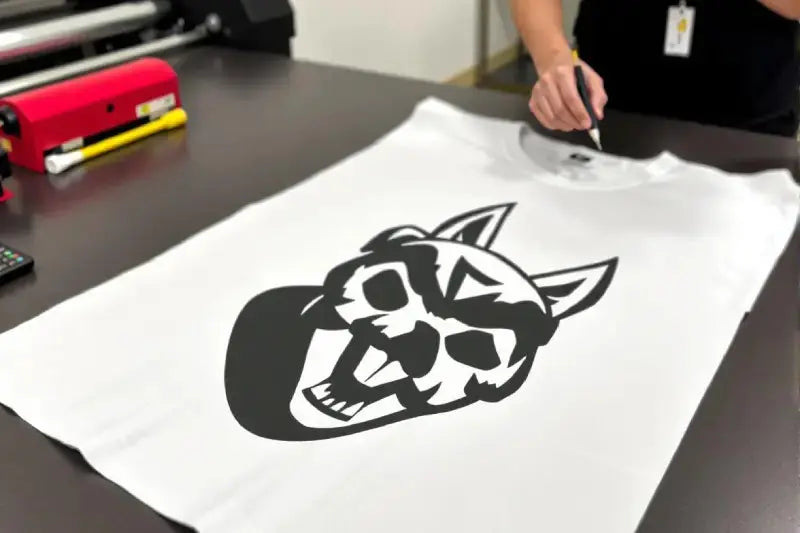Spandex is awesome for workout clothes, dance outfits, and swimsuits because it's super stretchy and breathable, all while being durable. But getting prints on it with DTF (Direct to Film) printing can be tricky, and therefore, there is a high likelihood that you may encounter DTF printing mistakes with spandex.
Common DTF printing issues occur because spandex stretches significantly more than other fabrics, such as cotton and blends; it doesn't heat up like cotton, and it behaves erratically under pressure. Small mistakes can lead to cracks, DTF powder curing issues, or prints that flake off fast.
But here’s the thing: if you know what to look out for while printing on spandex, DTF can give you high-definition and long-lasting prints on workout gear. Let’s check out the most common DTF printing issues with DTF on spandex and how to avoid them.
Mistake #1: Using the Wrong Film or Powder
You can't just use any DTF film or powder on spandex. Some novice designers use the same film they use for cotton shirts, thinking it'll be okay, but since spandex stretches significantly, using the wrong material can cause the print to crack or lead to DTF transfer errors.
How to fix it:
-
Ask your DTF supplier for a film that stretches well and is tested on spandex.
-
Use powders that stay flexible after curing.
- If you're printing workout clothes, test the film on real spandex before a big order.
If you want to know how to fix peeling DTF transfers, then use the right film and powder to keep prints from cracking.
Mistake #2: Forgetting Stretch and Design Placement
Spandex clothes stretch most at elbows, knees, and chest. Putting a big logo there can cause cracks and lead to DTF print not sticking properly.
Better idea:
-
Put prints where there's less stretch, like the sides or upper back.
-
Keep designs small and simple.
- Use open space so the fabric moves naturally.
These are best practices for DTF transfer printing to keep fitness shirts and leggings looking great.
Mistake #3: Too Much Solid Ink
Lots of solid ink feels stiff and cracks first, which are classic DTF transfer errors.
Try instead:
-
Break down designs into smaller parts.
-
Use outlines or fades.
- Let the fabric color show through.
If you use the ink properly on spandex, you can create light, flexible prints that move well.
Mistake #4: Skipping Test Prints on Real Spandex
Testing on polyester or cotton to save money is tempting, but spandex is different. It may cause DTF print not sticking or weird warping.
Fix:
-
Always test on the actual spandex.
-
Stretch, wash, and wear to check durability.
- Adjust settings if needed.
Testing helps to prevent DTF transfer mistakes before big production runs.
Mistake #5: Wrong Heat Press Settings
Spandex can melt or scorch. Too much heat leads to burnt spots, which are irreparable.
Tips:
-
Use lower heat (275–300°F / 135–150°C).
-
Use medium, even pressure.
-
Cure a bit longer instead of hotter.
These are classic heat press mistakes to avoid for better results.
Mistake #6: Forgetting About Fabric Mixes
Blends like nylon/spandex react differently and can create DTF powder curing issues.
What to do:
-
Adjust press settings for each fabric.
-
Keep notes on what works best.
Good record-keeping helps with DTF printer maintenance tips and consistency.
Mistake #7: Not Designing for Stretch
Thin lines crack easily under tension, and this is what causes DTF prints to peel off.
Design better:
-
Use thicker fonts and rounded shapes.
-
Avoid sharp corners.
-
Think about how the design will move.
How to get clean results with DTF transfers that look good? Design with the stretch in mind.
Mistake #8: Ignoring Room Conditions
Humidity too low? Static makes the film move. Too high? The powder clumps cause curing issues, leading to distorted prints.
Fix:
-
Keep humidity at 40–60%.
- Store films/powders sealed and dry.
- Good conditions prevent DTF transfer errors and messy prints.
Mistake #9: Skipping Color Check
Spandex reflects light differently, making prints look dull or off.
Fix:
-
Use ICC profiles.
-
Calibrate your screen.
-
Test print bright colors.
The right ICC profiles can ensure that your colors stay vibrant even on spandex.
Mistake #10: Storing Transfers Wrong
Rolling prints too tightly or keeping them near heat is what causes DTF prints to peel off.
Don’t do this:
-
Store flat, away from sunlight.
- Press only when needed.
These small steps keep prints smooth and professional.
DTF Printing on Spandex: Quick Tips
DTF can be awesome for stretchy spandex, but there are some things you should and shouldn't do. Here’s a simple guide to keep your prints looking good and staying flexible.
What to Do
-
Use the Right Stuff: Get films and powders made for stretchy material, so your prints don't crack or peel.
-
Think About Movement: Keep logos small, use thicker lines, and place prints where the fabric doesn't stretch as much, such as the sides or upper back.
-
Test First: Always print samples on actual spandex, stretch it, wash it, and see if it holds up.
-
Easy on the Heat: Use lower heat (around 275–300°F) and medium pressure to protect the fabric.
- Keep Your Printer Clean: Regularly clean the nozzles, shake the inks, and maintain a steady room humidity for smoother prints.
What Not to Do
-
Don't Use Too Much Ink: Big, solid prints crack easily. Break up your designs into lighter parts.
-
Pay Attention to Fabric Mixes: Nylon-spandex might need different heat settings.
-
Color Matters: Bad colors make prints look bad.
-
Peel Carefully: Peel the film slowly (either hot or cold, like it says) so you don't lift the edges.
- Store Transfers Flat: Keep them away from heat and sun so they don't warp or crack.
Why Choose Picasso DTF
At Picasso DTF, we test films and powders on real spandex and poly blends. That means softer, stretchier, longer-lasting prints.
Plus, we help with color profiles and DTF printer maintenance tips so your brand can deliver pro-level workout gear. Save time, waste less, and impress your customers.
Final Thoughts
Spandex is a highly stretchable fabric, which means that it can lead to DTF printing mistakes regardless of how good your setup is or how good your artwork is. Choose stretchable films, design smart, test on real spandex, and manage your heat and humidity. Small steps help you preserve and protect your brand by preventing DTF transfer errors that can ruin prints and cost you both time and money. Over time, good techniques become routine, so your prints stay sharp with each press.
Ready to start printing on spandex? Check out our DTF Sample Pack and Gang Sheet Builder to test transfers on spandex before printing in bulk.

